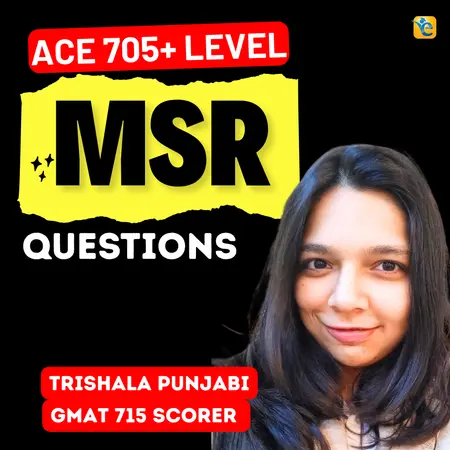Events & Promotions
|
|

GMAT Club Daily Prep
Thank you for using the timer - this advanced tool can estimate your performance and suggest more practice questions. We have subscribed you to Daily Prep Questions via email.
Customized
for You
Track
Your Progress
Practice
Pays
Not interested in getting valuable practice questions and articles delivered to your email? No problem, unsubscribe here.
- Nov 22
11:00 AM IST
-01:00 PM IST
Do RC/MSR passages scare you? e-GMAT is conducting a masterclass to help you learn – Learn effective reading strategies Tackle difficult RC & MSR with confidence Excel in timed test environment - Nov 23
11:00 AM IST
-01:00 PM IST
Attend this free GMAT Algebra Webinar and learn how to master the most challenging Inequalities and Absolute Value problems with ease. - Nov 25
10:00 AM EST
-11:00 AM EST
Prefer video-based learning? The Target Test Prep OnDemand course is a one-of-a-kind video masterclass featuring 400 hours of lecture-style teaching by Scott Woodbury-Stewart, founder of Target Test Prep and one of the most accomplished GMAT instructors.
Kudos
Bookmarks
E
Be sure to select an answer first to save it in the Error Log before revealing the correct answer (OA)!
Difficulty:
 5%
(low)
5%
(low)
Question Stats:
83% (01:08) correct 17%
(01:39)
wrong
17%
(01:39)
wrong  based on 1639
sessions
based on 1639
sessions
History
Date
Time
Result
Not Attempted Yet
In a certain baord game, a stack of 48 cards, 8 of which represent shares of stock, are shuffled and then placed face down. If the first 2 cards selected do not represent shares of stock, what is the probability that the third card selected will represent a share of stock?
A. 1/8
B. 1/6
C. 1/5
D. 3/23
E. 4/23
A. 1/8
B. 1/6
C. 1/5
D. 3/23
E. 4/23
Kudos
Bookmarks
rajman41
Yes you can. You already know that the first 2 cards are not stock cards. It's like we placed them face up. They anyway are out of the picture. Now we have 46 cards and 8 of them are stock cards. So the probability that the card we pick is a stock card is 8/46 = 4/23.
The probability of picking a stock card keeps increasing as we keep pulling out the non stock cards.
Think: You have 5 cards and 1 of them is the Queen. What is the probability that you will pull out a queen? It's 1/5. What happens after you pull out a non queen? The probability of pulling out a queen now becomes 1/4. It keeps increasing till you reach the last card. If you still haven't pulled out a queen, the last one must be the queen and the probability becomes 1.
Another thing to think about: What happens if you don't know what the first two cards are i.e. what is the probability of picking a share card on the third pick (you don't know what the first two picks are).
Kudos
Bookmarks
truongynhi
Hi,
you have given a Q above wherein there are 3 blacks and 5 white, and we are to find the probability that 4th is black..
here you are not aware what has happened in the first three DRAWS, so picking of all 8 will remain PROBABILITY..
But what happens when you have picked two cards and you are told they do not contain the card we are lookin for..
you had 48 cards out of which 8 are say TYPE X, and you have to find the probability that third is TYPE X..
Our probability will continue to be out of all 48..
If you are told first two are not type X...
so now you have ONLY 46 cards left, Because in the TWO picked, there is no probability involved since we know what those cards are..
Probability is ONLY there where we do not know the out come..
another extension of above Q..
you have picked 40 cards and none of them are type X..
what is the probability that 41st card will be X..
we now do not care of what we already know. they have moved from Probability to REALITY..
now we know 48-40=8 cards are left and none of type X has been picked..
so now all these 8 will be type X..
prob = 8/8 = 1.. that is it will be type X for sure..











